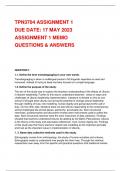TPN3704 ASSIGNMENT 1
DUE DATE: 17 MAY 2023
ASSIGNMENT 1 MEMO
QUESTIONS & ANSWERS
QUESTION 1:
1.1. Define the term translanguaging in your own words:
Translanguaging is when a multilingual person’s full linguistic repertoire is used and
honoured, instead of trying to keep narrowly focused on a single language.
1.2. Define the purpose of the study:
The aim of this study was to explore the teachers understanding of the effects of Ubuntu
in teacher leadership. Further to this was to understand teachers` views on ways and
challenges of Ubuntu leadership implementation. Literature is divided on this as one
school of thought sees Ubuntu as having the potential to change school leadership
through instilling of trust, role modelling, human dignity and going beyond the call of
duty. On the other side, literature does not see Ubuntu responding to the contemporary
school challenges like animal abuse, patriarchy, punctuality etc. Semi-structured
interviews, questionnaires and document reviews were instruments used to collect the
data. Semi-structured interview were the main instrument of data collection. Findings
showed that teachers understood Ubuntu be abiding by the Batho Pele policies. Ubuntu
is the theory of the study and advocates collectivism, trust, human dignity etc. Findings
of this study was that many teachers viewed role modelling as the important principle
and trust as the important value in implementation of Ubuntu.
1. 3. Name data collection methods used in the study:
Ethnography comes from anthropology, the study of human societies and cultures.
Ethnography seeks to understand how people live their lives. Through this method,
researchers veer away from the specific and practical questions that traditional market
, researcher’s use and instead observe the participants in a no directed way. This
approach is intended to reveal behaviours from a subject’s perspective rather than from
the view of the researchers.
Ethnography helps fill in the blanks when a participant may not be able to articulate their
desires or the reasons for their decisions or behaviours. Instead of, or in addition to,
asking why a participant acts a certain way, researchers use observation to understand
the why behind these desires, decisions, or behaviours.
Grounded theory arose when sociological researchers sought to provide a level of
legitimacy to qualitative research — to ground it in reality rather than assumptions.
Before this method, qualitative data analysis was actually done before any quantitative
data was collected, so it was disconnected from the collection and analysis process.
Grounded theory uses the following methods:
Participant observation. Researchers immerse themselves in the daily
lives of subjects. Another term for this is <fieldwork.=
Interviews. These can vary in formality from informal chats to
structured interviews.
Document and artefact collection. Grounded theory often is about
more than observation and interviews. Researchers can learn about a group of people
from looking at materials the group used. For example, a local community’s laws may
shed light on opinions and provide a clearer picture of residents’ sentiments.Sometimes,
a person’s true colours emerge only when they are genuinely put to the test. As such,
phenomenology describes how people experience certain events or unique encounters.
This method measures reactions to occurrences that are outside of the norm, so it’s
essential to understand the whole picture, not just facts and figures.
An example of phenomenology is studying the experiences of individuals involved in a
natural disaster. To analyse data from such an event, the researcher must become
familiar with the data; focus the analysis on the subject matter, time period, or other
factors; and categorize the data. Completing these tasks gives the researcher a
framework for understanding how the natural disaster impacts people. Together, the
understanding, focus, and organization help researchers identify patterns, make
connections, interpret data, and explain findings. Each of these qualitative data
collection methods sheds light on factors that can be hidden in simple data analysis.
Qualitative data is one way to add context and reality to raw numbers. Often,
researchers find value in a hybrid approach, where qualitative data collection methods
are used alongside quantitative ones.
4. Do you think translanguaging was or will (be) possible in your classroom? If
yes, Why? If no, Why?




